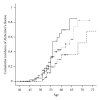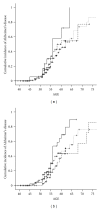Polymorphisms in HSD17B1: Early Onset and Increased Risk of Alzheimer's Disease in Women with Down Syndrome
- PMID: 22474448
- PMCID: PMC3310186
- DOI: 10.1155/2012/361218
Polymorphisms in HSD17B1: Early Onset and Increased Risk of Alzheimer's Disease in Women with Down Syndrome
Abstract
Background/Aims. Genetic variants that affect estrogen activity may influence the risk of Alzheimer's disease (AD). In women with Down syndrome, we examined the relation of polymorphisms in hydroxysteroid-17beta-dehydrogenase (HSD17B1) to age at onset and risk of AD. HSD17B1 encodes the enzyme 17β-hydroxysteroid dehydrogenase (HSD1), which catalyzes the conversion of estrone to estradiol. Methods. Two hundred and thirty-eight women with DS, nondemented at baseline, 31-78 years of age, were followed at 14-18-month intervals for 4.5 years. Women were genotyped for 5 haplotype-tagging single-nucleotide polymorphisms (SNPs) in the HSD17B1 gene region, and their association with incident AD was examined. Results. Age at onset was earlier, and risk of AD was elevated from two- to threefold among women homozygous for the minor allele at 3 SNPs in intron 4 (rs676387), exon 6 (rs605059), and exon 4 in COASY (rs598126). Carriers of the haplotype TCC, based on the risk alleles for these three SNPs, had an almost twofold increased risk of developing AD (hazard ratio = 1.8, 95% CI, 1.1-3.1). Conclusion. These findings support experimental and clinical studies of the neuroprotective role of estrogen.
Figures



Similar articles
-
Estrogen receptor-Beta variants are associated with increased risk of Alzheimer's disease in women with down syndrome.Dement Geriatr Cogn Disord. 2011;32(4):241-9. doi: 10.1159/000334522. Epub 2011 Dec 8. Dement Geriatr Cogn Disord. 2011. PMID: 22156442 Free PMC article.
-
HSD17B1 gene polymorphisms and risk of endometrial and breast cancer.Cancer Epidemiol Biomarkers Prev. 2004 Feb;13(2):213-9. doi: 10.1158/1055-9965.epi-03-0241. Cancer Epidemiol Biomarkers Prev. 2004. PMID: 14973105
-
Haplotype analysis of the HSD17B1 gene and risk of breast cancer: a comprehensive approach to multicenter analyses of prospective cohort studies.Cancer Res. 2006 Feb 15;66(4):2468-75. doi: 10.1158/0008-5472.CAN-05-3574. Cancer Res. 2006. PMID: 16489054
-
Estrogen associated gene polymorphisms and their interactions in the progress of Alzheimer's disease.Prog Neurobiol. 2013 Dec;111:53-74. doi: 10.1016/j.pneurobio.2013.09.006. Epub 2013 Oct 3. Prog Neurobiol. 2013. PMID: 24096044 Review.
-
Estrogen pathway polymorphisms and mammographic density.Anticancer Res. 2011 Dec;31(12):4369-86. Anticancer Res. 2011. PMID: 22199302 Review.
Cited by
-
Association of Alzheimer Disease With Life Expectancy in People With Down Syndrome.JAMA Netw Open. 2022 May 2;5(5):e2212910. doi: 10.1001/jamanetworkopen.2022.12910. JAMA Netw Open. 2022. PMID: 35604690 Free PMC article.
-
Usefulness of DNA Methylation Levels in COASY and SPINT1 Gene Promoter Regions as Biomarkers in Diagnosis of Alzheimer's Disease and Amnestic Mild Cognitive Impairment.PLoS One. 2016 Dec 19;11(12):e0168816. doi: 10.1371/journal.pone.0168816. eCollection 2016. PLoS One. 2016. PMID: 27992572 Free PMC article. Clinical Trial.
-
Age effects on cortical thickness in young Down's syndrome subjects: a cross-sectional gender study.Neuroradiology. 2015 Apr;57(4):401-11. doi: 10.1007/s00234-014-1482-4. Epub 2015 Jan 6. Neuroradiology. 2015. PMID: 25560246
-
Trans-acting epigenetic effects of chromosomal aneuploidies: lessons from Down syndrome and mouse models.Epigenomics. 2017 Feb;9(2):189-207. doi: 10.2217/epi-2016-0138. Epub 2016 Dec 2. Epigenomics. 2017. PMID: 27911079 Free PMC article. Review.
-
Estrogen Formation and Inactivation Following TBI: What we Know and Where we Could go.Front Endocrinol (Lausanne). 2020 May 29;11:345. doi: 10.3389/fendo.2020.00345. eCollection 2020. Front Endocrinol (Lausanne). 2020. PMID: 32547495 Free PMC article. Review.
References
-
- Luine VN. Estradiol increases choline acetyltransferase activity in specific basal forebrain nuclei and projection areas of female rats. Experimental Neurology. 1985;89(2):484–490. - PubMed
-
- O’Malley CA, Dean Hautamaki R, Kelley M, Meyer EM. Effects of ovariectomy and estradiol benzoate on high affinity choline uptake, ACh synthesis, and release from rat cerebral cortical synaptosomes. Brain Research. 1987;403(2):389–392. - PubMed
-
- Yamamoto H, Kitawaki J, Kikuchi N, et al. Effects of estrogens on cholinergic neurons in the rat basal nucleus. Journal of Steroid Biochemistry and Molecular Biology. 2007;107(1-2):70–79. - PubMed
Grants and funding
LinkOut - more resources
Full Text Sources

